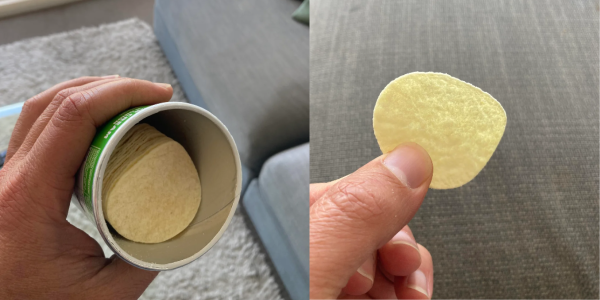You're not imagining it! Uncover the reason why Pringles have shrunk
Everyone loves a good snack every once in a while, and sometimes we tend to go for our favourite brands. One of the popular ones is Pringles.
However, there's something you should know about Pringles before you decide to make a purchase: they have now become smaller. If you have been one of the many frustrated shoppers raising 'shrinkflation' claims about the famous stacked chips, this article is for you.
Recently, there's been a commotion over how small the chips in a packet of Pringles have become. Someone shared photos of a 53g can of Sour Cream & Onion Pringles on social media and even held up a chip to illustrate the point.
'I didn't believe it till now, these Pringles are tiny,' they stated.
The post garnered unhappy comments from social media users, with one saying: ‘Thought they were above shrinkflation. My disappointment cannot be measured by the new size of these Pringles.’
Another commenter wrote: ‘I had the same problem. How can they get away with this?’
‘And they know you'll still buy,’ a third person expressed.
The snack comes in 134g containers, and the smaller 53g cans sold for about $5 and $2.50, respectively. Previously, a regular-sized tube of Pringles weighed 150g.
According to the manufacturer, the slight difference in size between the regular-sized tubes and the smaller cans is because the company has moved the Asia-Pacific Region's production to a new, state-of-the-art one in Malaysia. It is understood that the company did not change the price.
‘As our Malaysia plant was already servicing our Asian market, we decided we would standardise production and roll out the same Pringles recipe, chip size and packaging from this location for Australia and New Zealand,’ a spokesperson confirmed.
Pringles cited that the higher production costs of the new cans forced the price increase.
‘What's great about the new plant is that we'll have more flexibility with launching new products and flavours that are tailored to our tastes, which over the last five years has been loved by our consumers,’ the spokesperson added
The company spokesperson failed to mention whether the product has since become any smaller.
Shrinking sizes and rising costs have become an increasing concern for Aussies looking to stretch their budget.
Recently, we shared multiple reports of products hit by ‘shrinkflation’. A size change has affected some products, including Cottee’s Apricot Jam, Nescafe Coffee, and even Ritz Crackers have been affected by a size change. But the price on most of the products remains the same, making shoppers disappointed for not getting the same quantity as they did before.
Several manufacturers claimed higher production and ingredient costs and supply chain problems as causes for these changes.
Our members also noticed the change in their favourite products:
Member @Geoff8 wrote: ‘I have noticed the “shrinkflation” on Cadbury choc bars. A bar costs $3.75 for 165 grams and 180 grams, as some haven’t been changed yet. This week in Coles, they were 2 for $7.00, which equals 330 grams or 360 grams. However, if you look at the bigger bars of 360 grams, they are $6.00 and, to me, a far better price than getting 2.’
‘P.S. I love my chocolate but have stopped buying as much,’ he added.
Member @Apg shared: ‘I was really cranky when I noticed Roses jam went from 500 gms to 375 gms, but the cost remained the same. That’s a reduction of 25% in quantity, but the price doesn’t reflect this. Cottee’s Jam also shrunk the same but is cheaper than Roses. I agree, if the company had been upfront about it, I wouldn’t have felt so disrespected as a customer.’
Member @NANNA4B said: ‘Yes, I found this with a 4-pack of Turkish bread from Coles, they have shrunk quite a bit!’

What do you think of this story, members? Can you share other products that have been affected by ‘shrinkflation’? Let us know in the comments below!
However, there's something you should know about Pringles before you decide to make a purchase: they have now become smaller. If you have been one of the many frustrated shoppers raising 'shrinkflation' claims about the famous stacked chips, this article is for you.
Recently, there's been a commotion over how small the chips in a packet of Pringles have become. Someone shared photos of a 53g can of Sour Cream & Onion Pringles on social media and even held up a chip to illustrate the point.
'I didn't believe it till now, these Pringles are tiny,' they stated.
The post garnered unhappy comments from social media users, with one saying: ‘Thought they were above shrinkflation. My disappointment cannot be measured by the new size of these Pringles.’
Another commenter wrote: ‘I had the same problem. How can they get away with this?’
‘And they know you'll still buy,’ a third person expressed.
The snack comes in 134g containers, and the smaller 53g cans sold for about $5 and $2.50, respectively. Previously, a regular-sized tube of Pringles weighed 150g.
According to the manufacturer, the slight difference in size between the regular-sized tubes and the smaller cans is because the company has moved the Asia-Pacific Region's production to a new, state-of-the-art one in Malaysia. It is understood that the company did not change the price.
‘As our Malaysia plant was already servicing our Asian market, we decided we would standardise production and roll out the same Pringles recipe, chip size and packaging from this location for Australia and New Zealand,’ a spokesperson confirmed.
Pringles cited that the higher production costs of the new cans forced the price increase.
‘What's great about the new plant is that we'll have more flexibility with launching new products and flavours that are tailored to our tastes, which over the last five years has been loved by our consumers,’ the spokesperson added
The company spokesperson failed to mention whether the product has since become any smaller.
Shrinking sizes and rising costs have become an increasing concern for Aussies looking to stretch their budget.
Recently, we shared multiple reports of products hit by ‘shrinkflation’. A size change has affected some products, including Cottee’s Apricot Jam, Nescafe Coffee, and even Ritz Crackers have been affected by a size change. But the price on most of the products remains the same, making shoppers disappointed for not getting the same quantity as they did before.
Several manufacturers claimed higher production and ingredient costs and supply chain problems as causes for these changes.
Our members also noticed the change in their favourite products:
Member @Geoff8 wrote: ‘I have noticed the “shrinkflation” on Cadbury choc bars. A bar costs $3.75 for 165 grams and 180 grams, as some haven’t been changed yet. This week in Coles, they were 2 for $7.00, which equals 330 grams or 360 grams. However, if you look at the bigger bars of 360 grams, they are $6.00 and, to me, a far better price than getting 2.’
‘P.S. I love my chocolate but have stopped buying as much,’ he added.
Member @Apg shared: ‘I was really cranky when I noticed Roses jam went from 500 gms to 375 gms, but the cost remained the same. That’s a reduction of 25% in quantity, but the price doesn’t reflect this. Cottee’s Jam also shrunk the same but is cheaper than Roses. I agree, if the company had been upfront about it, I wouldn’t have felt so disrespected as a customer.’
Member @NANNA4B said: ‘Yes, I found this with a 4-pack of Turkish bread from Coles, they have shrunk quite a bit!’
Key Takeaways
- A Pringles consumer has complained about the apparently decreasing size of the chips in the container, sparking controversy about the brand and claims of 'shrinkflation'.
- Pringles confirmed that they did reduce the chips and cans size in 2016 due to a change in manufacturing location and equipment. However, the prices did not drop to reflect the smaller sizes.
- Despite the changes, the company claimed higher production costs with the new cans had forced a price increase.
- Consumers have been increasingly concerned about shrinking product sizes and rising costs, with many accusing different brands of giving a smaller quantity for the same price.
What do you think of this story, members? Can you share other products that have been affected by ‘shrinkflation’? Let us know in the comments below!








